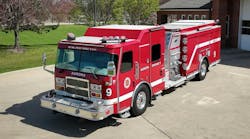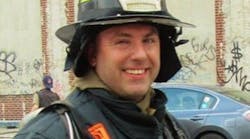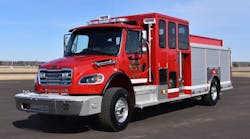Firehouse Magazine recently asked fire apparatus manufacturers to join a roundtable addressing the important issue of the 2007 vehicle emissions standards. Specifically, we invited apparatus manufacturers' chief engineers or their representatives to describe the ways in which they are working with their customers to meet those standards. We asked each company to discuss what the new standards mean to fire departments purchasing apparatus, installation of new engines, and ways in which manufacturers are helping departments design and build apparatus capable of carrying all of the equipment and supplies needed to respond to all types of emergencies. We thank the companies that participated in this roundtable and invite all apparatus manufacturers to participate in upcoming exchanges of important information.
AMERICAN LaFRANCE
Doug Kelley
Pumper Product Manager
American LaFrance
Doug Kelley, the pumper product manager for American LaFrance, graduated from the U.S. Naval Academy in 1991 with a bachelor of science degree in mechanical engineering. He served in the Navy until 1996. During that time, he graduated from the Navy's Damage Control Assistant School with training in firefighting and rescue. He also was a 2.5-year member of the damage control training team on the cruiser USS Mississippi out of Norfolk, VA. From 1996 to 2003, Kelley was chief engineer for S&S Fire Apparatus. He oversaw the development of many new products, including the industry's first commercial non-metallic elliptical tanker. Kelley has worked for American LaFrance since 2003.
Firehouse: What do 2007 emission standards mean to the fire department buying an apparatus when these standards change? What does it mean to the fire apparatus manufacturer that must install a new engine?
Kelley: American LaFrance has been working closely with engine manufacturers to manage the implementation of the 2007 standards. This will be a major change in engine and emissions control. The heart of the issue is that the new standards require significantly lower nitrous oxide (NOX) and particulate emissions.
Engine manufacturers are each handling the technical details in their own way. However, there are three universal consequences. First, the engines will be getting bigger and more complex, especially for larger horsepower configurations. Second, the engines will require a significant increase in heat rejection, so the cooling packages will need to be redesigned and enlarged. Third, the aftertreatment and exhaust systems will greatly increase in complexity and importance.
The increase in size of the engine and cooling system means that most manufacturers are going to have to make major changes in cab design. The engine and radiator will require more volume and air flow, and thus, the cab tunnels will be wider and/or taller. The exterior dimensions of the cab may also change to preserve interior room.
The increase of complexity means that there will be several new devices, both electronic and mechanical, mounted on the engine to make sure the engine is functioning properly. This will impact the ability of many service facilities to maintain the engines at their current level of training.
The change to the aftertreatment systems means that it will no longer be acceptable to simply relocate the muffler at will. The muffler/diesel particulate filter will be increasing in size, and therefore the body and pump systems will need to be specifically designed to accommodate it. In addition, there will be electronic sensors installed in the aftertreatment system, including near the tailpipe, to monitor system performance. There will be an operational impact in that periodically the system will require a regeneration cycle in which the engine operates at a higher RPM and higher temperature to clear the particulate filter. Finally, the aftertreatment system will become a serviceable part of the vehicle with periodic maintenance required.
There will be other impacts as well. You can expect the price of the unit to increase, possibly the fuel efficiency to drop, and the performance characteristics to change. However, these will vary from engine to engine.
American LaFrance is working diligently to prepare for the 2007 change. Some of our current products, such as our Mid-Engine Eagle cab, are particularly well suited for the new engines without sacrificing cab interior space or engine serviceability. However, regardless of manufacturer, everyone has significant challenges in preparing for the change and certifying the new technology.
Firehouse: Can you suggest ways to help fire departments design and incorporate all the varied specialized equipment they need to carry on apparatus today?
Kelley: Here are three suggestions:
1. Create an inventory - You can't create a storage plan without knowing what the truck will carry. Make a list of everything you can think of, and note if it has any special storage requirements (such as it needs to be plugged in) or location requirements (such as it should be stored at the back of the truck). This list should be used in creating the bid specs, especially if any equipment will impact the design of the truck. Examples of items that will need factory assistance are custom storage racks, power supplies, RFI protection, or special environmental or climate needs. This inventory can also be used to plan the layout of the compartments. Your dealer or manufacturer will be an excellent resource for this process.2. Plan who will do the work - There are many options here. First, the manufacturer can install the equipment; if so, they will require specific details to make sure the engineering is complete. Second, the dealer can install the equipment before delivering the truck. This is common because the dealer is likely to have experience in different techniques and equipment that may make the job easier. Third, you can do the work yourself. In this case, you can still work with the dealer and manufacturer to properly prep the apparatus with items such as shelves, mounting channels, slotted toolboards, etc. It's extremely important that you consult with the manufacturer for mounting requirements. Do not assume that you can drill just anywhere or that you will be able to tie into the electrical system on your own. More than one tank has been punctured and wiring harness fried by departments that did not follow this advice.
3. Plan for future growth - The equipment load you carry today may not be the load you carry 10 years from now. Where possible, preserve space for additional growth. Utilize adjustable shelves, trays and toolboards so you can vary the space. Use removable storage bins that can be relocated at will. Make sure that equipment racks are secured to the vehicle via threaded fasteners instead of welding. And when you buy that new piece of equipment, pre-plan where it's going to go. And never be afraid to consult your dealer or manufacturer in the process, even if the truck is many years old.
DARLEY
Michael C. Ruthy
Vice President - Engineering
W.S. Darley & Co.
Michael C. Ruthy, vice president - engineering for W.S. Darley, graduated from Lafayette College in 1985 with a bachelor of science degree in mechanical engineering. He was employed at Hale Inc. (now Hale Products) from 1985 to 1989, and has been with Darley since 1989.
Firehouse: What do 2007 emission standards mean to the fire department buying an apparatus when these standards change? What does it mean to the fire apparatus manufacturer that must install a new engine?
Ruthy: At the fire department's level, I don't expect them to see big changes. The new standards have been common knowledge for years and the major engine manufacturers have all announced programs for meeting the new levels. The 2007 trucks will be equipped with a particulate filter, which may be subject to clogging if poor fuels are chosen. Particulate filters work best with Ultra Low Sulfur Fuel (ULSF), which is only available in a limited extent in 2007. While it will be the only type of diesel for sale by 2010, departments may want to work with their fuel suppliers to ensure the more appropriate fuel will be used on their newer trucks. The good news is that most engine manufacturers are reporting increases in fuel economy have been achieved at the same time emissions were reduced.
Firehouse: Can you suggest ways to help fire departments design and incorporate all the varied specialized equipment they need to carry on apparatus today?
Ruthy: Determining what equipment to carry will vary from locality to locality based on individual community needs. A great resource for planning a new truck is the Fire Apparatus Manufacturers' Association's new cube and weight calculator, which lists typical size and weight figures for hundreds of pieces of equipment that are suggested or required by ISO and NFPA. It can make planning one's compartment space a lot more convenient. It's posted on their website at www.fama.org.
PIERCE
Tom Decoster
Director of Engineering
Pierce Manufacturing
Tom Decoster received a bachelor of science degree from Michigan Technological University. At Pierce Manufacturing, he is director of engineering, responsible for all aspects of design and development for production engineering and new product development. Decoster has been with Pierce Manufacturing for 10 years, serving as plant manager, refurbishment manager, director of customer service and technical service, director of product management and director of engineering. Prior to Pierce Manufacturing, he spent 11 years in the wood products industry.
Firehouse: What do 2007 emission standards mean to the fire department buying an apparatus when these standards change? What does it mean to the fire apparatus manufacturer that must install a new engine?
Decoster: Fire departments will see several changes in the installation of the engine and the support systems for the engine, and changes will most likely vary by apparatus manufacturer. Cooling systems will be larger due to the increased levels of heat that these new engines will give off into the engine coolant and air intake systems. Air cleaners may be larger due to the increased airflow for the air intake system. In addition, the exhaust system will change substantially due to the new requirements for exhaust catalysts and particulate filters.
Overall, the physical size of the engine is increasing, as well as the weight. This creates packaging issues, as well as the need to review the weight that will be added to the front axle. All of these changes will force fire apparatus manufacturers to review a significant portion of their overall vehicle design. Cab engine tunnels, cooling, air intake, and exhaust systems, engine and transmission mounting configurations, frame design, front suspension and axle selection, and electrical requirements all must be considered. Even pumphouse and body designs require review due to the now more stringent exhaust design requirements.
Firehouse: Can you suggest ways to help fire departments design and incorporate all the varied specialized equipment they need to carry on apparatus today?
Decoster: As departments work on their new spec, they need to work closely with their apparatus manufacturer to understand the challenges specialized equipment may pose when installed on a 2007 engine-equipped chassis. While at Pierce we try to make sure that we cover the bases on option designs, the fire industry is a custom, build-to-order market. Placement of equipment in a certain location on previously-purchased trucks may not be the best place on a 2007 engine-equipped chassis due to items such as exhaust placement, heat sensitivity, or blockage of front end air flow. In the end, the truck is a tool that the firefighter uses to do his job, and the equipment that the firefighter needed on pre-2007 trucks needs to be there on the post-2007 vehicles. The idea is not to limit what can be put onto the truck, but to make sure that it meets each departments' needs without compromising the requirements of the engine.





